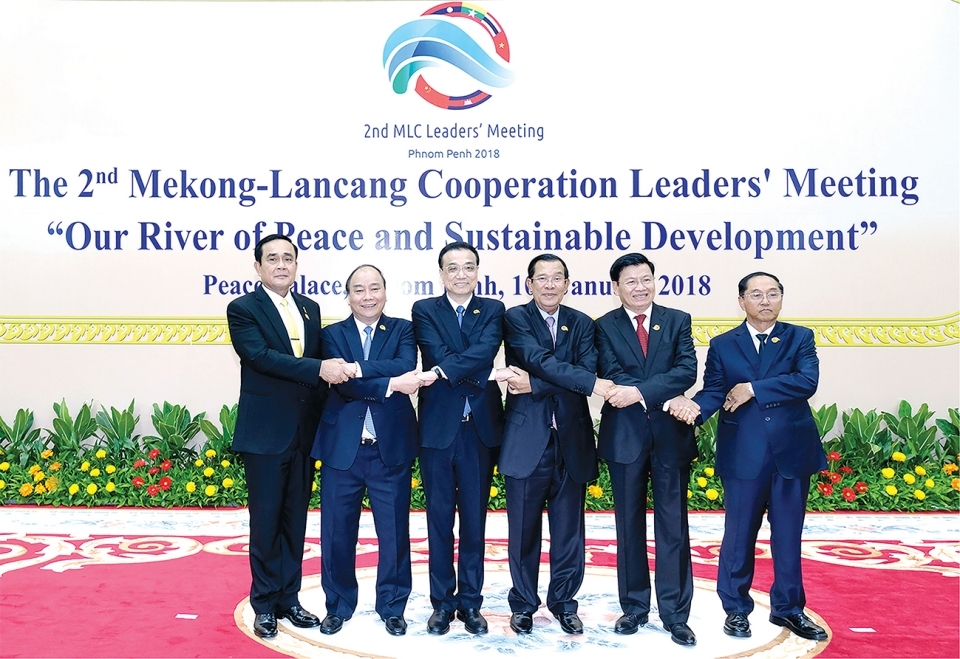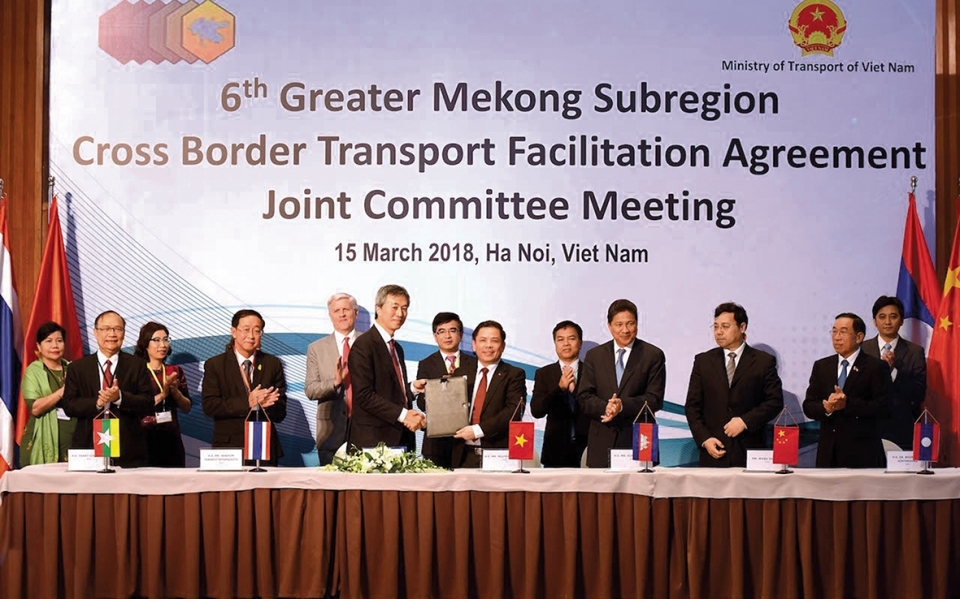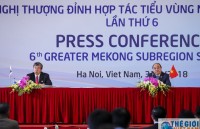
GMS: 25 years of development
Latest
| TIN LIÊN QUAN | |
| Developing infrastructure to promote transportation connectivity in GMS countries | |
| Building GMS, CLV regions of sustainable, prosperous development | |
Following the great success of APEC 2017, which culminated in the APEC Economic Leaders’ Week in Da Nang, GMS6, held in Ha Noi, is one of the most important multilateral diplomacy activities of 2018. Although Vietnam is an open economy with a relatively high level of economic integration and a member of many regional and global free trade areas, but the cooperation within GMS still plays a very important role in economic, politic, security, national defense and socio-cultural terms.
3 “C” pillars
The Greater Mekong Subregion Economic Cooperation Program was initiated in 1992 with the support of the Asian Development Bank (ADB). The members of GMS are Cambodia, Laos, Myanmar, Thailand, Vietnam and China (represented by the provinces of Yunnan and Guangxi). The long-term goal of the program is to facilitate mutually beneficial economic development among its members and make the Greater Mekong Subregion a rapidly growing and prosperous region in Southeast Asia.
 |
| The 2nd Mekong - Lancang Cooperation Leaders' Meeting in Cambodia. |
GMS was established at the same time that Vietnam was once more eligible for ODA, three years before joining ASEAN and one year after normalizing relations with China. Thus, it can be said that joining GMS was the first step of Vietnam's integration into the region and the world after the Cold War. Although ADB is the facilitator of the GMS process, the initiative is oriented by the countries themselves, with a strong focus on joint action to address common challenges, based on the three “C” pillars: Connectivity, Competitiveness and Community. This comprehensive approach to regional development has resulted in encouraging outcomes.
GMS is the most inclusive cooperation program in the Mekong Subregion, prioritizing infrastructure development, energy, telecommunications, tourism, trade - investment, human resources development and the environment. Transport infrastructure is a top priority area with the most remarkable outcomes, focusing on three main economic corridors: i) North-South Economic Corridor (NSEC); ii) East-West Economic Corridor (EWEC; iii) Southern Economic Corridor (SEC).
Of these three corridors, the East-West Corridor linking the Pacific and Indian Oceans was completed in 2007, realizing the dream of "having breakfast in Vietnam, lunch in Lao and dinner in Thailand”. GMS countries have initially piloted the provisions of the GMS Agreement on Customs Inspection at a number of border checkpoints along the EWEC corridor, namely Mukdahan - Savanakhet and Dansavanh - Lao Bao.
China has fundamentally completed the transport infrastructure for the two corridors of Kunming - Lao Cai - Hai Phong and Nanning - Lang Son - Hai Phong and is expecting Vietnam to expedite the launch of these two routes. China is also promoting cooperation with several upstream countries (Thailand, Myanmar) to transport oil and build railways through these countries to connect with the region and the world. Recognizing the great potential of the Mekong region, China has actively participated in the GMS program since 2004.
The two Chinese provinces Guangxi and Yunnan share a border with Viet Nam. Guangxi is a mountainous province in Southern China with about 50 million people. Its economy is yet developed with literacy rates that differ among regions. Yunnan is a Southwestern province, covering an area of 380,000 km2, located on the Yungui plateau with a population of over 40 million people belonging to 24 ethnic groups. Kunming, the capital of Yunnan province, has an area of 15,000 square kilometers and a population of 3,200,000 people.
Yunnan is an important gateway of the Southwestern provinces of China into the East Sea and Southeast Asia. Although far from the Mekong basin, Guangxi lies in the heart of the ASEAN-China Free Trade Area. On the other hand, Guangxi has eight border districts adjacent to Vietnam with 12 border gates, railways and roads that connect directly to Ha Noi, creating favorable conditions for the two sides to expand investment cooperation.
More effort, closer cooperation
With an area of 2,6 million square kilometers and a population of over 340 million people, the GMS possesses great economic potential and a key geo-political position. However, this is also a region with low and uneven levels of development, faced with great exposure to climate change. GMS is currently developing a strategic framework for the period of 2012-2022, which was adopted at the 4th Summit held in December 2011 in Myanmar. The theme “Committed to Inclusive and Sustainable Development in the GMS” was adopted at the 5th GMS Summit in Bangkok in December 2014.
 |
So far, GMS has held five high-level summits and 22 ministerial meetings. The 22nd Ministerial Meeting held in Vietnam, September 2017 ratified the Ha Noi Action Plan. This is a very important plan to realize the GMS Strategic Framework until 2022, calling for the expansion of economic corridors to increase connectivity between countries as well as between rural areas and urban centers to ensure the benefits are more evenly distributed.
At this summit, the GMS ministers approved a pipeline list of 222 investment and technical assistance projects worth 64 billion USD. The Ha Noi Action Plan is the guideline for the next five years, which will be reviewed and approved by GMS leaders at the 6th GMS Summit. In order to effectly implement the elements of GMS cooperation, much hard work remains in the years ahead. To this end the mechanism needs closer cooperation and more efforts to mobilize resources from development partners and further promote the participation of the private sector, so as to build momentum and confidence for GMS cooperation in the coming time.
The new Transport Strategy requires an efficient, reliable and sustainable GMS transport system. This goal can be achieved by improving connectivity links with South Asia and other regions in Southeast Asia, promoting cross-border transportation, enhancing inter-modal connectivity and developing logistic services while improving road traffic safety.
GMS Tourism Sector Strategy 2016-2025 was also adopted to develop more competitive, more balanced and more sustainable touristic destinations. In the field of agriculture, policies to promote safe and environmentally friendly agricultural products should be implemented. It is also desirable to have a plan to strengthen value chain integration, with the participation of farming small-holders, rural women and small and medium agribusiness enterprises.
GMS has undertaken a long journey of 25 years. As the Secretariat of GMS Cooperation, ADB has coordinated and raised more than 20 billion USD in investment excluding national investment projects, built 10,000 km of expressways, 500 km of railways, 2000 power lines... and taken part many other projects.
In addition to the tangible monetary value, an effective inter-regional framework has been developed to motivate member countries to expand cooperation, maintain sustainable development and reduce poverty. At this GMS Summit, Vietnam will for the first time raise the GMS Business Summit initiative, aiming at strengthening dialogue between businesses and the state and foster networks among regional and global businesses.
By Trinh Quang Chinh
 | Sixth Greater Mekong Subregion Summit a success The sixth Greater Mekong Subregion (GMS-6) Summit wrapped up successfully with many key documents ratified, Prime Minister Nguyen Xuan Phuc affirmed at an international press ... |
 | GMS-6 and CLV-10: Economic connectivity for sustainable development The sixth Greater Mekong Subregion (GMS-6) Summit and the 10th Cambodia-Laos-Vietnam (CLV-10) Development Triangle Summit continue taking place in Hanoi on March 31, the last ... |
 | First-ever GMS Business Summit opens in Ha Noi The first-ever Greater Mekong Subregion (GMS) Business Summit opened in Ha Noi on March 30 as part of the sixth GMS Summit (GMS-6) and the ... |

















